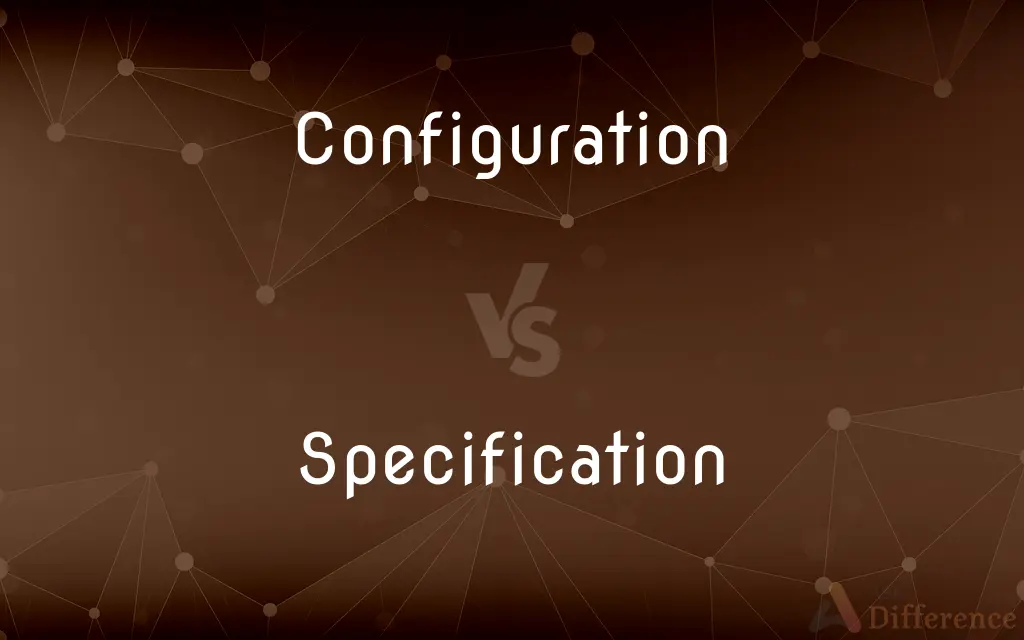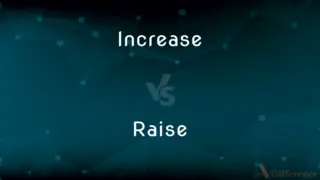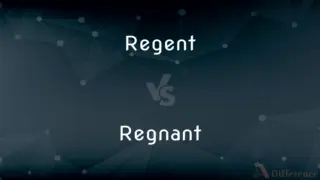Configuration vs. Specification — What's the Difference?
Edited by Tayyaba Rehman — By Maham Liaqat — Updated on March 26, 2024
Configuration involves arranging components for operation within a system, focusing on customization for specific needs. Specification details exact requirements or standards that components or systems must meet, emphasizing predefined criteria.

Difference Between Configuration and Specification
Table of Contents
ADVERTISEMENT
Key Differences
Configuration refers to the process of selecting and setting up system components to meet the specific needs of a user or to optimize functionality. This can involve software settings, hardware arrangement, or network parameters, tailored to achieve desired performance or to accommodate particular applications. On the other hand, specification involves detailing the precise requirements or standards that components, systems, or processes must adhere to. This includes dimensions, materials, performance criteria, and quality standards that ensure compatibility, reliability, and efficiency.
While configuration is an action primarily focused on customization and adjustment, specification acts as a guideline or blueprint that dictates the essential criteria for components or systems. Configuring a device involves making choices within the framework of its specifications; thus, configuration is about implementing or utilizing specifications to achieve a tailored outcome. For instance, the specification of a smartphone includes its hardware capabilities, such as processor speed and memory size, while its configuration might involve setting up the operating system, apps, and connectivity options according to the user's preferences.
The process of configuration is dynamic and can change over the life of a system or product, reflecting the adaptability to new requirements or improvements. As technologies or user needs evolve, reconfiguration may be necessary to maintain or enhance performance. Conversely, specifications are generally static and defined at the design or manufacturing stage, serving as the benchmarks against which a product or system is built and evaluated. Changes to specifications often imply a significant redesign or alteration of the product itself.
Configuration often requires a detailed understanding of the system’s capabilities and the user's needs, involving decision-making to balance performance, cost, and functionality. It is a user-centric process that reflects specific requirements or preferences. Specification, however, is more prescriptive, outlining the necessary attributes and performance targets that a product or system must achieve, usually derived from technical, safety, and regulatory standards.
Both concepts play critical roles in technology development and deployment. Effective configuration ensures that systems or products are tailored to meet specific operational needs, enhancing usability and performance. Specification, by providing clear and precise criteria, ensures compatibility, safety, and reliability, guiding the development and assessment of technology solutions.
ADVERTISEMENT
Comparison Chart
Definition
Setting up system components to meet specific needs or optimize functionality.
Detailing precise requirements or standards for components or systems.
Focus
Customization and adjustment.
Predefined criteria and standards.
Nature
Dynamic and adaptable.
Static and defined at the design or manufacturing stage.
Purpose
To achieve desired performance or accommodate particular applications.
To ensure compatibility, reliability, and efficiency.
Role in Development
Implemented to utilize specifications for a tailored outcome.
Acts as a guideline or blueprint for design and evaluation.
Changes Over Time
Can change to reflect new requirements or improvements.
Generally remain static unless significant redesign occurs.
User-Centric
Yes, involves decision-making based on user needs and preferences.
Less so, as it outlines necessary attributes and performance targets.
Compare with Definitions
Configuration
Adjusting software settings for optimal performance.
Configuring the firewall settings to enhance network security.
Specification
The detailed requirements for manufacturing a component.
The specification for the alloy used in aircraft wings.
Configuration
Setting up a device with specific applications and preferences.
Configuring a smartphone with custom apps and display settings.
Specification
Standards for materials and construction methods.
The specification for waterproofing materials in building construction.
Configuration
Tailoring a computer system’s hardware components.
Configuring a gaming PC with a high-performance graphics card and SSD.
Specification
Precise performance criteria for software applications.
The specification outlining the minimum system requirements for running a video editing software.
Configuration
Customizing network parameters for specific tasks.
Configuring a router to prioritize bandwidth for video streaming.
Specification
Regulatory requirements for safety and emissions.
The vehicle specification that includes emissions standards compliance.
Configuration
Optimizing a database system for faster query responses.
Configuring the database indexing strategy for efficiency.
Specification
Quality benchmarks for product testing.
The specification that sets the durability standards for smartphones.
Configuration
Another term for gestalt
Specification
The act of specifying.
Configuration
An arrangement of parts or elements in a particular form, figure, or combination
The broad configuration of the economy remains capitalist
The unrepeatable configuration of the stars at the moment of your birth
Specification
Specifications A detailed, exact statement of particulars, especially a statement prescribing materials, dimensions, and quality of work for something to be built, installed, or manufactured.
Configuration
(Chemistry) The structural arrangement of atoms in a compound or molecule.
Specification
A single item or article that has been specified.
Configuration
(Computers) The way in which a computer system or network is set up or connected.
Specification
An exact written description of an invention by an applicant for a patent.
Configuration
(Psychology) Gestalt.
Specification
An explicit set of requirements to be satisfied by a material, product, or service.
Configuration
Form, as depending on the relative disposition of the parts of a thing's shape; figure; form factor.
Specification
An act of specifying.
Configuration
Relative position or aspect of the planets; the face of the horoscope, according to the relative positions of the planets at any time.
Specification
The act of specifying or determining by a mark or limit; notation of limits.
This specification or limitation of the question hinders the disputers from wandering away from the precise point of inquiry.
Configuration
The way things are arranged or put together in order to achieve a result.
Specification
The designation of particulars; particular mention; as, the specification of a charge against an officer.
Configuration
The arrangement of electrons in an atom, molecule, or other physical structure like a crystal.
Specification
A written statement containing a minute description or enumeration of particulars, as of charges against a public officer, the terms of a contract, the description of an invention, as in a patent; also, a single article, item, or particular, an allegation of a specific act, as in a charge of official misconduct.
Configuration
(algebra) A finite set of points and lines (and sometimes planes), generally with equal numbers of points per line and equal numbers of lines per point.
Specification
A detailed listing or description of the required properties of some object proposed to be built or bought; - usually used in the plural; as, the building specifications require that it withstand an earthquake of magnitude 8; the program specifications require an option to change the menus.
Configuration
Form, as depending on the relative disposition of the parts of a thing; shape; figure.
It is the variety of configurations [of the mouth] . . . which gives birth and origin to the several vowels.
Specification
A detailed description of design criteria for a piece of work
Configuration
Relative position or aspect of the planets; the face of the horoscope, according to the relative positions of the planets at any time.
They [astrologers] undertook . . . to determine the course of a man's character and life from the configuration of the stars at the moment of his birth.
Specification
Naming explicitly
Configuration
An arrangement of parts or elements;
The outcome depends on the configuration of influences at the time
Specification
(patent law) a document drawn up by the applicant for a patent of invention that provides an explicit and detailed description of the nature and usse of an invention
Configuration
Any spatial attributes (especially as defined by outline);
He could barely make out their shapes through the smoke
Specification
A restriction that is insisted upon as a condition for an agreement
Common Curiosities
What does specification mean?
Specification refers to detailed requirements or standards that products, systems, or processes must meet, including materials, dimensions, and performance criteria.
Is configuration a one-time process?
No, configuration can change over time to accommodate new requirements, technologies, or user needs.
Can a product have multiple configurations?
Yes, a single product can have multiple configurations to cater to different performance requirements or user preferences.
How do user preferences influence configuration?
User preferences significantly influence configuration choices, as settings and setups are adjusted to meet individual or organizational needs.
Why are specifications important in manufacturing?
Specifications ensure that products are built to meet necessary safety, quality, and performance standards, guiding manufacturing processes.
What is configuration in technology?
Configuration in technology involves setting up system components, such as software or hardware, to meet specific operational needs or preferences.
How does configuration differ from specification?
Configuration is about customizing and adjusting systems to desired settings, while specification details the essential criteria and standards a system must adhere to.
Can specifications change once set?
While specifications are generally static, significant redesign or development advances can lead to updates in specifications.
What role do specifications play in product development?
Specifications act as blueprints in product development, outlining the essential requirements a product must meet.
Are specifications only related to physical products?
No, specifications can also apply to software, processes, and services, detailing requirements across various domains.
How is configuration managed in large organizations?
Large organizations use configuration management tools and policies to ensure consistent setups across multiple systems and devices.
How do configurations impact system performance?
Proper configuration can optimize system performance, enhancing efficiency, usability, and functionality.
What is the significance of adhering to specifications?
Adhering to specifications ensures compatibility, reliability, and compliance with regulatory and safety standards.
How do specifications influence design choices?
Design choices are often guided by specifications to ensure that the final product meets all required standards and criteria.
Can configurations be standardized?
While configurations are often tailored to specific needs, certain standard configurations may be developed for common scenarios or applications.
Share Your Discovery

Previous Comparison
Increase vs. Raise
Next Comparison
Regent vs. RegnantAuthor Spotlight
Written by
Maham LiaqatEdited by
Tayyaba RehmanTayyaba Rehman is a distinguished writer, currently serving as a primary contributor to askdifference.com. As a researcher in semantics and etymology, Tayyaba's passion for the complexity of languages and their distinctions has found a perfect home on the platform. Tayyaba delves into the intricacies of language, distinguishing between commonly confused words and phrases, thereby providing clarity for readers worldwide.
















































